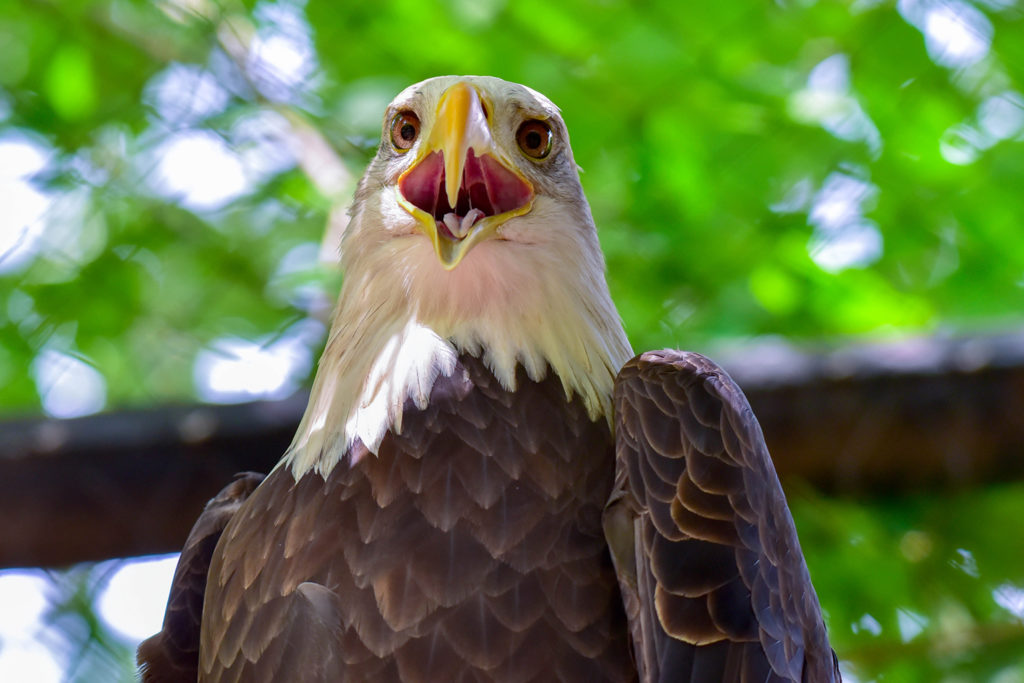Overview
“Where I live”
Bald eagles are found across Canada, the United States, and northern Mexico. They typically live in forested areas near rivers, lakes, or marshes where they can find fish. Haines, Alaska prides itself on being home to the largest concentration of bald eagles in the world. Bald eagles also live in Maryland year round, mostly along the Chesapeake Bay and its tributaries.
“How I live there”
Bald eagles are often seen alone or in pairs, soaring high in the sky, perched on deadfall at the top of a tree or cliff, scanning for prey below. In winter, they often gather in large numbers along the coast, hunting by day and roosting together at night.
These raptors are big, strong, opportunistic predators. Fish are their staple food, and they tend to swoop down and snatch fish in their talons from the water’s surface. They go after many other kinds of food as well, including birds, crustaceans, amphibians, reptiles, and small mammals. They hunt, scavenge, and even harass and steal prey from other animals such as osprey and otter.
As noble and majestic as the bald eagle appears, its reputation for piracy is well established. “He is a Bird of bad moral Character,” wrote Benjamin Franklin of the bald eagle. “He does not get his Living honestly.” In choosing a symbol for the new American nation, Franklin favored the wild turkey over the bald eagle.
“Making my mark”
The bald eagle was chosen as America’s national symbol in 1785. It is the only eagle native only to North America. It is the second largest bird of prey on the continent behind the California condor. It stands nearly three feet tall and has a wingspan greater than six feet.
Raising Young
Bald eagles mate for life. Courtship often involves spectacular aerial displays, with a male and female locking talons and tumbling in the air together. Pairs become highly territorial during breeding season. They build large nests usually in the tops of tall trees. In treeless areas, they may nest in a cliff face or on the ground. Pairs tend to return to the same nests each year and continue adding to them, which results in some of the largest nests on the planet! Some bald eagle nests have measured 10 feet across and weighed half a ton.
Female bald eagles lay clutches of 1 to 3 eggs once a year and incubate them for about 35 days. By three months of age, bald eaglets can fly but remain dependent on their parents for up to 6 more weeks and may live near their parents for a year or longer. Eventually, young bald eagles go off and live nomadically, exploring vast territories for several years before returning to the area of their births to breed for the first time.
It takes about five years for young bald eagles to acquire their adult plumage. Until then, they are entirely brown and can be mistaken for golden eagles. You can tell them apart by looking at their legs. Bald eagles have unfeathered lower legs.
“What threatens me”
Once common throughout North America, this species of eagle declined dramatically between the start of the 18th century and the latter part of the 20th century. By the late 1970s, bald eagles were in danger of extinction throughout most of their range.
The causes of decline were many. Bald eagles were threatened by overhunting, habitat loss, and poisoning by lead shot and pesticides, particularly DDT. The birds would ingest fish contaminated by DDT, and the chemical then hampered their ability to produce strong eggs. Eggshell thinning resulted in fewer viable eggs, which contributed to a crash in the bald eagle reproductive rate. For many decades, bald eagles also were mistakenly perceived as marauding predators that would attack chickens, lambs, and other domestic livestock. Many were killed by farmers as a result.
The species received protective status in the United States under the Bald Eagle Protection Act in 1940 (now the Bald and Golden Eagle Protection Act), and later under the Endangered Species Act of 1973.
Conservation
Saving bald eagles from extinction is one of North America’s most successful wildlife conservation stories. The first step on their road to recovery was the banning of DDT by the Environmental Protection Agency in 1972. Listing the species as endangered in 1978 also helped tremendously because it allowed for important conservation measures to be taken, including captive breeding programs, reintroduction efforts, law enforcement, and protection of nest sites during breeding season.
The bald eagle was removed from the Endangered Species list in 2007 because the species is once again doing well throughout most of its range, including Maryland. However, bald eagles are still monitored and protected in the United States. It is still illegal to kill, harm, or sell any type of eagle or their eggs or their nests.
Taxonomy
- Kingdom: Animalia
- Phylum: Chordata
- Subphylum: Vertebrata
- Class: Aves
- Order: Accipitriformes
- Family: Accipitridae
- Genera: Haliaeetus
- Species: leucocephalus




